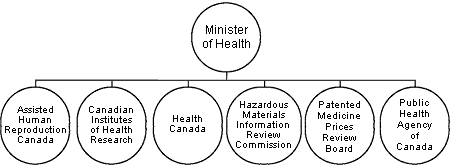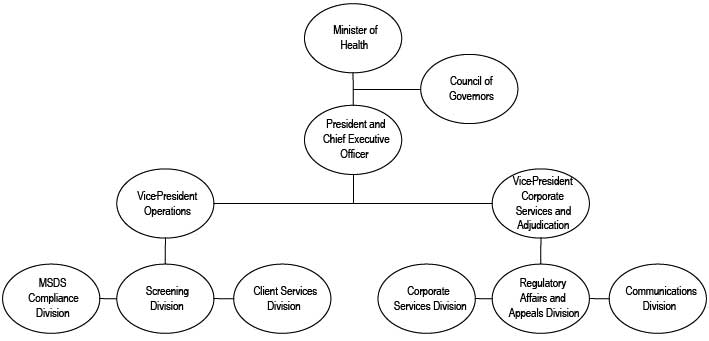Common menu bar links
Breadcrumb Trail
ARCHIVED - RPP 2007-2008
Hazardous Materials Information Review Commission
 This page has been archived.
This page has been archived.
Archived Content
Information identified as archived on the Web is for reference, research or recordkeeping purposes. It has not been altered or updated after the date of archiving. Web pages that are archived on the Web are not subject to the Government of Canada Web Standards. As per the Communications Policy of the Government of Canada, you can request alternate formats on the "Contact Us" page.
Section III – Supplementary Information
Appendix A: Health Portfolio Organization

Appendix B: Organizational Information

The Council of Governors constitutes the key element of the Commission's governance structure, acts as an advisory body and provides strategic advice and guidance to the Commission. The Council consists of 18 members: two representing workers, one representing suppliers and one representing employers, one representing the federal government, and between four and 13 representing the provincial and territorial governments. Each governor is appointed by the Governor in Council for up to three years. The Council is headed by a chairperson chosen by the governors for a term of one year. The Council is responsible for making various recommendations to the Minister of Health, including changes to the regulations related to the Commission's fee structure, the procedures for reviewing claims for exemption and the appeal procedures.
Most Council members concurrently represent other occupational health and safety organizations, and thus are part of the existing multi-jurisdictional occupational health and safety network.
The President and CEO is appointed by the Governor in Council and has the authority and responsibility to supervise and direct the organization's work on a day-to-day basis. The President is accountable to Parliament through the Minister of Health.
The Vice-President of Operations directs the work of the MSDS Compliance, Screening and Client Services divisions.
The Vice-President of Corporate Services and Adjudication directs the work of the Corporate Services, Regulatory Affairs and Appeals, and Communications divisions.
Appendix C: Departmental links to the Government of Canada Outcomes
| ($ thousands) | Budgetary | Total Main Estimates |
Total Planned Spending | ||
|---|---|---|---|---|---|
| Operating | Gross | Net | |||
| Strategic Outcome: Trade secret exemptions within WHMIS that balance the right of industry to withhold bona fide confidential business information with the right of employers and workers to be provided with complete and accurate information on the health and safety hazards posed by workplace chemicals. | |||||
| Claims Exemption Process | 3,506 | 3,506 | 3,506 | 3,506 | 3,506 |
| Total | 3,506 | 3,506 | 3,506 | 3,506 | 3,506 |
Claims Exemption Process contributes to the achievement of the Government of Canada's "Healthy Canadians" outcome.
Table 1: Departmental Planned Spending Table and Full-time Equivalents
| ($ thousands) | Forecast Spending 2006–2007 | Planned Spending 2007–2008 | Planned Spending 2008–2009 | Planned Spending 2009–2010 |
|---|---|---|---|---|
| Claims Exemption Process | 3,512 | 3,506 | 3,506 | 3,506 |
| Budgetary Main Estimates (gross) | 3,512 | 3,506 | 3,506 | 3,506 |
| Total Main Estimates | 3,512 | 3,506 | 3,506 | 3,506 |
| Adjustments | ||||
| Supplementary Estimates | ||||
| Operating budget carry forward | 145 | – | – | – |
| Other | ||||
| Treasury Board Vote 15 | 61 | – | – | – |
| Employee Benefit Plan (EBP) | 12 | – | – | – |
| Total Adjustments | 218 | – | – | – |
| Total Planned Spending | 3,730 | 3,506 | 3,506 | 3,506 |
| Total Planned Spending | 3,730 | 3,506 | 3,506 | 3,506 |
| Less: Non-respendable revenue | (570) | (570) | (570) | (570) |
| Plus: Cost of services received without charge | 743 | 723 | 723 | 723 |
| Total Departmental Spending | 3,903 | 3,659 | 3,659 | 3,659 |
| Full-Time Equivalents | 35 | 35 | 35 | 35 |
Table 2: Voted and Statutory Items listed in Main Estimates
| Vote or Statutory Item | Truncated Vote or Statutory Wording | 2007–2008 Main Estimates |
2007–2008 Main Estimates |
|---|---|---|---|
| 25 | Program expenditures | 3,024 | 3,019 |
| (S) | Contributions to employee benefit plans | 482 | 493 |
| Total Department or Agency | 3,506 | 3,512 |
The difference between the 2007–2008 and 2006–2007 Main Estimates results from the collective agreement funding.
Table 3: Services Received Without Charge
| ($ thousands) | 2007–2008 |
|---|---|
| Accommodation provided by Public Works and Government Services Canada | 541 |
| Contributions covering employers' share of employees' insurance premiums and expenditures paid by Treasury Board of Canada Secretariat (excluding revolving funds) | 182 |
| Salary and associated expenditures of legal services provided by the Department of Justice Canada | – |
| Total 2007–2008 Services received without charge | 723 |
Table 4: Sources of Non-Respendable Revenue
| ($ thousands) | Forecast Revenue 2006–2007 | Planned Revenue 2007–2008 | Planned Revenue 2008–2009 | Planned Revenue 2009–2010 |
|---|---|---|---|---|
| Claims Exemption Process | ||||
| Claim Registration Fees | 570 | 570 | 570 | 570 |
| Total Non-Respendable Revenue | 570 | 570 | 570 | 570 |
These are estimated revenues for fees paid by Canadian and international chemical manufacturers and distributors for the registration and review of claims for exemption under WHMIS and its related legislation.
Table 5: Resource Requirement by Sector
| ($ thousands) | Claims Exemption Process | Total Planned Spending |
|---|---|---|
| Claims Processing | 3,331 | 3,331 |
| Dispute Prevention / Appeals | 175 | 175 |
| Total | 3,506 | 3,506 |
The resources requirement for corporate services are included in the Claims Processing and Dispute Prevention/Appeals resource requiremen
